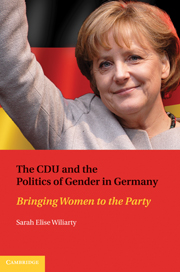Book contents
- Frontmatter
- Contents
- List of Figure and Tables
- Acknowledgments
- The CDU and the Politics of Gender in Germany
- Introduction: A Democratic Paradox?
- 1 The Puzzle of CDU Policy Making on Women's Issues
- 2 The Corporatist Catch-All Party Model
- 3 The Postwar CDU: Origins of a Corporatist Catch-All Party
- 4 The Emergence of the Women's Union, 1969–1982
- 5 The Women's Union in the Dominant Coalition, 1982–1989
- 6 Looking Eastward: The Women's Union and Cobbled Coalitions, 1989–1998
- 7 The Rise of Angela Merkel: Policy and Personnel Decisions of the CDU in Unified Germany
- 8 Christian Democracy With and Without Corporatism: Policy Making on Women's Issues in Austria, Italy, and the Netherlands
- 9 Conclusion
- Appendix: List of Cited Interviews
- List of References
- Index
1 - The Puzzle of CDU Policy Making on Women's Issues
Published online by Cambridge University Press: 17 November 2010
- Frontmatter
- Contents
- List of Figure and Tables
- Acknowledgments
- The CDU and the Politics of Gender in Germany
- Introduction: A Democratic Paradox?
- 1 The Puzzle of CDU Policy Making on Women's Issues
- 2 The Corporatist Catch-All Party Model
- 3 The Postwar CDU: Origins of a Corporatist Catch-All Party
- 4 The Emergence of the Women's Union, 1969–1982
- 5 The Women's Union in the Dominant Coalition, 1982–1989
- 6 Looking Eastward: The Women's Union and Cobbled Coalitions, 1989–1998
- 7 The Rise of Angela Merkel: Policy and Personnel Decisions of the CDU in Unified Germany
- 8 Christian Democracy With and Without Corporatism: Policy Making on Women's Issues in Austria, Italy, and the Netherlands
- 9 Conclusion
- Appendix: List of Cited Interviews
- List of References
- Index
Summary
At the beginning of the twenty-first century, it is easy to take for granted a “natural” affinity between women and parties of the left. Particularly from an American perspective, the long-standing partnership between the (mainstream) feminist movement and the Democratic Party substantiates this relationship. Yet in most western democracies, including the United States, from the time women were granted suffrage until at least the 1970s, the “natural” affinity was between women and parties of the right (Duverger 1955; Campbell, Converse, Miller, and Stokes 1960; Lipset 1960; Butler and Stokes 1974). Inglehart and Norris call this voting difference the “traditional gender gap” (Inglehart and Norris 2003).
Germany was no exception to this trend. Once women in Germany gained the vote in 1919, they tended to support conservative parties, especially if those parties were religious in orientation (Molitor 1992: 24; Bremme 1956: 71). During the Weimar Republic, women voted for the Center Party and the German National People's Party. In the first decades after World War II, women were more likely than men to support Christian Democratic parties (Molitor 1992: 25).
Women were more likely to vote for conservative parties in general (and the CDU in particular) for a variety of reasons. Women tend to live longer and older people are often more conservative; women also tend to be more religious; women were less likely to be employed outside the home and housewives were particularly likely to be conservative (Bremme 1956; Lipset 1960; Molitor 1992: 33–6; Inglehart and Norris 2003: 77).
- Type
- Chapter
- Information
- The CDU and the Politics of Gender in GermanyBringing Women to the Party, pp. 19 - 39Publisher: Cambridge University PressPrint publication year: 2010



